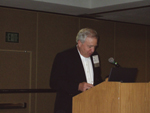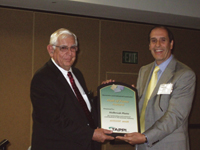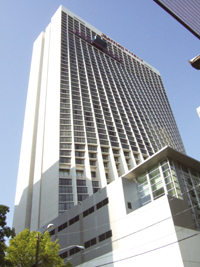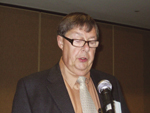Papers on paper
6 October 2008A pulp and paper industry association may seem to have little to do with the panel industry, but the Decorative and Industrial Laminates (DIL) Committee works hard to put together a very relevant conference every two years.
This year was no exception, with a programme covering: Introduction; Specifications; Savings/Productivity; Innovation; Green/environmental; Green/product rating; and Economic and market directions, in the seven main sessions. An eighth session of workshops discussed laminate flooring and marketing.
Michel Fortin, chairman of the DIL committee for 2006-8, introduced the symposium – and the first speaker, Dr Constantine LaPassa of North Carolina State University.
Opening Session 2, Dr LaPassa described the new, 2008, NALFA Laminate Flooring Standard. Test protocols have been amended to give explicit treatment of underlayment; improve reproducibility; and better reflect in-service conditions. A new test for surface bond strength has also been added.
The speaker concluded that performance values now better reflect the end-use of the products.
Sylvie Gauthier, technical writer, then gave an overview of decorative overlay standards for foils, light basis-weight papers, films and thermally-fused papers.
She said that the Laminated Materials Association (LMA) has produced a separate standard for each type of overlay, with a description of the attributes of each. It also sets minimum requirements or expected values for surface properties and prescribes test methods from NEMA LD3 (2005), ASTM and ‘industry-accepted methods’. In a throwback to earlier times, NEMA stands for National Electrical Manufacturers’ Association.
The CPA (Composite Panel Association), now merged with the LMA, is soon to publish a compendium of the various standards, said Ms Gauthier.
Daniel C Nelson of DCN Technology looked at the US and international standards for high pressure decorative laminate (HPDL).
Like the previous speaker, he referred to NEMA LD3 and said the standard can seen at www.nema.org/stds/ld3.cfm.
Mr Nelson also listed the major parts of the European standard for HPL – EN438, 2005 – saying that it was similar in content to the NEMA standard but goes further because it includes compact laminates and specifications for flooring applications.
“We need one harmonised standard that really works. We’ve been trying, but it is a long and hard road and won’t happen any time soon,said the speaker.
Structured troubleshooting: A roadmap for an analysis of laminate performance was the title of Berthold Dombo’s (DSM Melamine Americas Inc) presentation, which opened Session 3.
He said that 39% of melamine consumption worldwide is accounted for by LPL (low pressure laminate) production and 8% by HPL.
Mr Dombo presented his company’s structured approach to solving performance problems in laminates, defining the problems and describing the range of analytical techniques used.
Going in a completely different direction, Jim Scott of Mead Westvaco Corporation presented a paper on the biological treatment of speciality paper mill effluent.
He said that while primary treatment can remove particulate/fibrous material, in order to meet National Pollution Discharge Elimination System rules his company had to develop a biological secondary system. This ultimately returned water to the river from whence it came cleaner than when it was extracted, said Mr Scott.
Ending the morning session of day one of the two-and-a-half day symposium, respected industry veteran Holbrook F Platts gave a resume of the history of decorative high pressure laminates.
The Hall of Fame Luncheon followed (see box text).
Session 4 on ‘Innovation’ was opened by Ron Rodeck of AET Films with a talk on Oriented Polypropylene Films (OPP).
Acknowledging the contribution and development of paper- and vinyl-based overlays, Mr Rodeck said that paper inherently has poor water resistance and vinyl “is under severe environmental pressure”.
Describing OPPs as “the new decorative laminate option”, the speaker admitted that the simplest, calendered polypropylene (PP) films had poor adhesion characteristics and print quality, with high coverage costs.
“The properties can be enhanced by extruding and orienting the PP to produce thin and strong films, but there are still poor adhesion and robustness issues,said Mr Rodeck, claiming the answer is AET’s new biaxially-oriented enhanced OPP, or E-OPP.
Among advantages he claimed for E-OPP was that it is greener, does not absorb ink like paper does, has superior print fidelity and can act as a ‘living hinge’ between panels, which will not fatigue, tear or split.
The next speaker was Sven Kramer of Bürkle North America Inc. He described the company’s system for digital printing directly onto wood based panels as presented at the Ligna exhibition in Germany in 2007. Mr Kramer claimed the following as some of the advantages for his company’s technology: unlimited design flexibility, almost immediate design change within a production run, a photo-realistic image and reduction of production costs for small batch runs.
Lightweight panels for furniture manufacture have been raising increasing interest in recent years and another Bürkle man, Brent Warren, presented the company’s complete production line for fully-framed or frameless honeycomb panels.
Jonathan Shaw of Cytec Industries Inc looked at Technological trends in panel finishing, covering radiation curing and powder coating.
He said that what he called “energy curingcould be by means of ultra-violet (UV) radiation, visible light, or high-energy electrons. The coatings are cured, not dried as in conventional water- or solvent-based systems, he explained, saying that this had the advantage of endless pot-life for the coating material.
“Why use energy curing?asked Mr Warren, rhetorically. “Because it is very fast – seconds versus hours for conventional drying – and the cost per cured part is less than for solvent- or water-borne finishes. The equipment also has a small footprint and uses less energy.”
He said that such coatings could be used on paper which is to be laminated to MDF or particleboard to give increased chemical, scratch and abrasion resistance.
The speaker went on to describe powder coating as another ‘green’ technology, employing no liquids or solvents, and said that UV powder coatings can save time and energy.
The second day of the symposium, and the opening of session 5 on green and environmental issues, was opened by Ray Barbee of major North American panel maker Roseburg Forest Products. His subject was ‘being green in the wood business’.
“We are one of the few companies which believes that owning timberlands is a good thing and we have over 750,000 acres,he said.
Roseburg’s products include: softwood plywood; lumber; composite panels; speciality panels, such as hardwood plywood, MDO (medium density overlay) panels, marine plywood and melamine-faced panels; engineered wood products; and “Green Building Products”.
“What’s green about us?asked Mr Barbee. “Nothing new. We maintain our timberlands for timber and wildlife, we plant five million seedlings a year and we have used cogeneration for a long time and we make composite and plywood panels with no added urea formaldehyde.”
Roseburg also has a wide array of environmental certification, with its Californian timberlands FSC (Forest Stewardship Council) certified.
Roseburg plans to use methane gas from Montana land-fills to run its Missoula particleboard mill’s dryers.
Mr Barbee forecast that most of today’s green initiatives will be ‘business as normal’ in the future, that UF resin will no longer be used in any panel type and that cogeneration/biomass plants will continue to shorten fibre supply.
Next up, Beth Studley of Holder Construction Co and chair of the US Green Building Council, Atlanta Chapter, explained sustainable design and LEED certification. This stands for Leadership in Energy and Environmental Design and certification is obtained via a system of credits earned for the use of recycled materials, FSC timber and so on.
Steelcase claims to be the largest office furniture manufacturer in the world and Mary Ellen Mika gave a presentation on what makes for ‘green’ office furniture and how to comply with the extremely stringent ‘McDonough Braungart Design Chemistry’s Cradle to Cradle’ certification. This examines every single component of a piece of furniture, whether it is actually exposed or not.
Laminates can contain undesirable chemical components and Ms Mika suggested that, for their part, laminate providers should use 100% recycled content/renewable FSC-certified underlayment, using no added-formaldehyde resins, and that laminate should be attached using no adhesive, or adhesives that are Greenguard/FES (Furniture Emission Standard) certified with no VOCs or halogenated solvents.
Session 6 was again on green issues, with regard to product rating, and John Bradfield, the CPA’s director of environmental affairs, was on hand to explain CARB (California Air Resources Board) certification as it applies to the Composite Wood Air Toxic Control Measure or ATCM. This requires third-party certification of all hardwood plywood, particleboard and MDF panels sold in California or utilised in finished products sold there. January 2009 will present the first of many deadlines with which manufacturers will have to comply.
Still on the subject of the CARB regulations, Mike Zimmerman of Sauder Woodworking Company, a furniture manufacturer, described how such a company must be able to trace all supplies for compliance – and label its products correctly. He also touched on the implications for imported furniture. “Imported products are a huge problem,he said. “They make the domestic situation look easy!”
As nobody wants two different stocks of finished product, be it panels or furniture – one for California and one for everywhere else – this is effectively national legislation, said the speaker.
Formaldehyde seems to be a word that is never far from anybody’s lips in the industry today and Betsy Natz of the Formaldehyde Council (a non-profit Washington DC-based trade association) was there to defend it.
“This is one of the most extensively studied chemicals in commerce and it would be almost unimaginable if we were to try to take it out of commerce completely,she said.
Tom Julia, president of the CPA, was the keynote speaker during lunch on this second day.
He reported that 95% of the particleboard, MDF and hardboard producers in North America (including Mexico) are members of his association.
The Decorative Surfaces Council is a stand-alone committee within the CPA and Mr Julia said the association’s “tag-linefor this year is Advancing the wood based panel and decorative surfacing industries.
He said the association was more proactive and has a more ‘green’ market focus. He added that the CPA has also opened its International Testing and Certification Centre (ITCC).
Perhaps surprisingly to some, with regard to the CARB rule Mr Julia declared: “The CPA supports the CARB rule and its conditional federalisation. There is no opportunity to roll this rule back. Our approach is to build a consensus and work towards a rule that will work”.
He did, however, express concerns about the proposed deconstructive testing of panels or furniture, such as removing the surface covering of the panels: “they would not be testing the product you sold, as it was sold,Mr Julia pointed out.
“We cannot afford to be passive or defensive when it comes to environmental matters Those who watch the world as it passes by are left behind to ponder their irrelevance,he concluded.
Session 7, Economic and market directions, was opened by Eric R Bober of Pöyry Forest Industry Consulting.
He said that LPM growth is decelerating, while Europe is the biggest market and drives global demand, and that Russia and Turkey are currently driving European demand.
In HPL/CPL (continuous pressure laminate) demand has stagnated in North America and Europe, while Asia is stable with regional differences. Western European companies are increasingly going down the continuous pressing route.
Mr Bober went on to say that surfacing remains a challenging business, but recovery is expected but he forecast that market growth for LPM and laminates will remain slow.
He said people and innovation/differentiation remain important to competitiveness in a down-cycle, and in the supply chain he forecast integration and clustering, acquisitions, partnerships or joint ventures and operational improvements such as network optimisation.
“European players have succeeded in creating value from both vertical and horizontal integration,he said.
Darrell Keeling works for Roseburg Forest Products, but his presentation was on behalf of the CPA as its chairman for 2008 and concerned the panel market outlook.
Mr Keeling cited production pressures as being rising resin costs and falling fibre supply with increasing competition for that raw material, including from biofuels as well as pellet production.
But it was not all doom and gloom. The speaker forecast: “the decade ahead holds great promise, with a housing recovery and a stronger industry with products configured to match green markets.
“We must get the formaldehyde issues behind us,concluded Mr Keeling.
Jim Gould of the Floor Covering Institute outlined the rapid development of laminate flooring in the last 15 years.
He suggested that in order to hit the commercial flooring market, a way needs to be found around the problem of expansion gaps.
Michael Huth of Mead Westvaco Corporation looked at the marketplace perception of laminates and cautioned against the perception of “cheap plastic laminates – that is only if we can’t tell the story.Mr Huth suggested that a higher price equals a higher perceived value to the consumer.
Launching session 8A, the laminate flooring workshop, Andrzej Denisiewicz of Technocell Dekor described the backing paper manufacturing technology for laminate flooring, pointing out that it plays a crucial role in keeping the panels flat, which is sometimes not fully understood.
Next came Dirk Koltze of machinery maker Siempelkamp, who described the advantages of that company’s multi-piston press for short-cycle pressing, with better pressure distribution in width and length.
Jean Briere of Shaw Industries Inc presented his paper on impregnation of paper for laminate flooring. He said the important process elements were: paper formation, expansion, saturability and surface properties. Also important are raw resins and their formulation, as well as plasticizers because melamine is so brittle.
This article can only be a brief overview of a conference that was packed with information on a wide range of subjects which will have been of interest to panel makers/processors and those involved in the overlay producing sector. If you would like further information, please visit www.tappi.org and click on Decorative/Industrial Laminates.
Hall of fame receives new members
During lunch on day one, under the guidance of Linn Yeager of DSM Melamine, five new members were inducted into the DIL Hall of Fame. This award recognises the significant achievements of a select few who have contributed to the development of the industry.
This year’s recipients were Holbrook Platts (left in photo, presented by Tony Damiano), Bill Hines, Brantley D Thomas Jnr, Merle DeMoulin and Israel S Ungar.
Retiring TAPPI DIL committee chairman Michel Fortin, was also recognised for his service, not with a Hall of Fame award, but with a bottle of his favourite wine.



